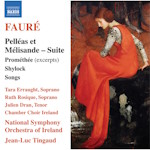Gounod: Petite Symphonie in B flat (1885)
Adagio et Allegretto
Andante cantabile
Scherzo: Allegro moderato
Finale: Allegretto
Known primarily today as a composer of opera – twelve altogether, of which Faust and Roméo et Juliette have more than held their place in the repertoire – Gounod has become a far less familiar figure outside the theatre; this despite their debt to him being acknowledged by a wide range of his younger compatriots, including Bizet, Saint-Saëns, Fauré, Massenet, Ravel. During his lifetime he achieved a renown above most other French composers of his era, and in Britain even rivalled the popularity of Mendelssohn – especially while living in London between 1870 and 1874. Having turned his back on theological studies, begun in 1847 at St. Sulpice (supposedly because he doubted his “capacity for celibacy”!), he became increasingly devout in later life, producing a number of religious works which were hugely successful – notably the oratorio La Rédemption. However, their appeal had faded by the turn of the century, and it proved to be the much earlier Messe solennelle de Sainte Cécile which outlived its successors – at its best displaying the colourful and dramatic influence of Berlioz, who had already been highly supportive, writing of an early Agnus Dei: ”[it] is beautiful – very beautiful. Everything in it is novel and distinguished – melody, modulation, harmony. In this piece M. Gounod has given proof that we may expect everything of him”. Two famous shorter pieces have helped to preserve his reputation: the Funeral March of a Marionette – composed in London for piano and later arranged for huge orchestra – attracted the attention in 1927 of none other than Alfred Hitchcock, who subsequently used it as signature tune for his own television series! Then there is the exquisite (but very clever) Méditation sur le Premier Prélude de Piano de S. Bach – literally a new melodic line for violin weaved over the first prelude from Book 1 of the “48”, which became the song Ave Maria when that text was added later.
The present symphony was actually his third, following two from the mid-1850s, in D major and E flat: both substantial works, acknowledging the dominating voice of Beethoven (but also Mendelssohn and Schumann) – with No.1 then inspiring Bizet to write his own astonishing C major symphony (aged just 17). Thirty years later Gounod was invited by the flautist Paul Taffanel to write a piece for the Société de musique de chambre pour instruments à vent; and so this Petite Symphonie received its first performance at the Salle Pleyel on 30 April 1885. The addition of an especially prominent flute part to the Classical Harmonie wind octet was no doubt intended to please M. Taffanel – and certainly adds an extra colour and dimension to the traditional ensemble. A delicacy and lightness of touch too, recalling his earlier admiration for Mendelssohn: as 1839 Prix de Rome winner he had met the composer’s sister Fanny in the Italian capital, who subsequently introduced him to her brother in Leipzig towards the end of his three-year stipend – the two composers then spent four congenial days together, during which the older shared with the younger his great love of JS Bach: indeed, a discreet mastery of 18th century counterpoint is to be found in this enchanting and sunny work, together with that fine sense of structure and balance which betokens the wisdom of age, plus a good helping of le bon goût. Although Gounod did actually compose three accomplished but totally neglected string quartets (No.3 in A minor is especially fine), it is this lovable wind symphony which seems to strike just the right balance between chamber music and more large scale forms.
© Alan George


















